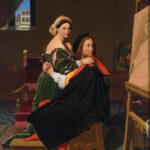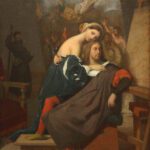Raffaello (1483-1520)
La Fornarina (Portrait of a Young Woman)
c.1520
Oil on panel, 87 x 63 cm
Palazzo Barberini, Roma
The subject of this portrait, according to tradition, was Raphael’s inspirational muse and mistress: Margherita Luti, the daughter of a baker in Trastevere, hence known as “Fornarina.” There is no record of any commission for the work, which supports the conjecture that Raphael painted it for himself in the last years of his life.
Whether she was Raphael’s mistress or not, behind this imperfect face with marked features lies a depiction of Venus. The pose of her hands, one placed on her lap and the other on her breast, follows the classic statuary model of the “Venus Pudica”: a gesture of modesty which yet directs the viewer’s gaze to what she actually seeks to conceal. Other symbols of the goddess of love are the bracelet inscribed with the words “Raphael Urbinas,” the painter’s signature as well as a token and pledge of love. The myrtle bush and branch of quince in the background are symbols of fertility.
The painting belonged to the original owners of the palazzo, the Sforza of Santafiora, and was one of the earliest works purchased by the Barberini family. (Galleria Barberini)
Compare:
 Ingres, Jean Auguste Dominique (1780-1867)
Ingres, Jean Auguste Dominique (1780-1867)
Raphaël et la Fornarina
1814
Fogg Museum, Cambridge, MA
 Ingres, Jean Auguste Dominique (1780-1867)
Ingres, Jean Auguste Dominique (1780-1867)
Raffaello e la figlia del fornaio
1846
Columbus Museum of Art, Columbus
